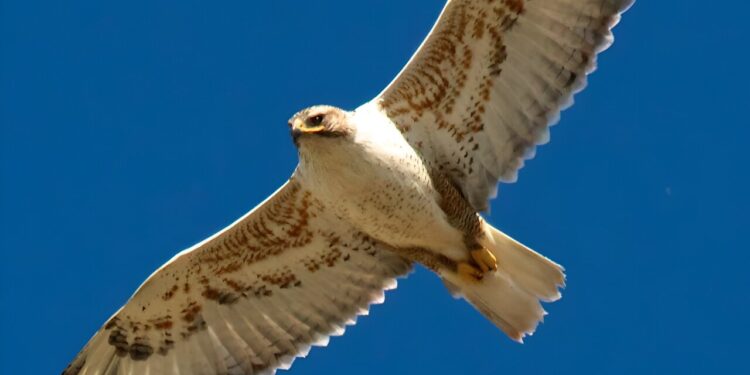Adult Ferruginous Hawk (Buteo regalis). Credit: Ed Harper
Ferruginous hawks (Buteo regalis) that winter in California appear to be increasing in number, but their preferred grassland habitat has been in decline for more than 20 years. Most other grassland bird species are unfortunately suffering the same fate: disappearing along with the open areas that once defined much of western North America.
In their new paper, “Population Trends of the Ferruginous Hawk (Buteo regalis) Wintering in California,” published in the Journal of Raptor ResearchLead author Edward Pandolfino and co-authors Lily Douglas of the U.S. Fish and Wildlife Service and Chris Ray of the Institute for Bird Populations, propose potential reasons for the surprising falcon population trend.
Their study shows how citizen science can shed light on unexpected realities occurring on raptors’ wintering grounds, a part of their annual cycle that receives less attention than the breeding season but has important implications for the health of the species.
Ferruginous hawks can be difficult to study. They are not reliably present at migration count sites because they do not concentrate along predictable topographic features (e.g., ridges) like many other migratory hawks. Demographic data for the species are conflicting in many locations, and as a result, their conservation status varies among states, regions, and even countries. Many individuals wintering in California breed in Washington or Oregon, where they are listed as endangered and critically sensitive, respectively.
Juvenile Ferruginous Hawk (Buteo regalis). Credit: Ed Harper
To investigate this inconsistent picture of the species’ status, Pandolfino and his team analyzed a citizen science dataset from the wintering grounds of the Washington-Oregon cohort. They looked at five bird conservation areas in California for which Christmas Bird Counts (CBCs) were conducted from 1998 to 2022.
Wildlife surveys are conducted on a voluntary basis by bird watchers and bird-related organizations, following a consistent protocol, to obtain data on the presence of bird species each December. These surveys provide a more reliable collection of data on the presence of the Ferruginous Hawk in a central part of its range than would be obtained by a research team operating under typical project parameters.
The team’s analysis found that while habitat quality declined significantly over the 25-year period, ferruginous hawk abundance increased over the same period in California. This is an unexpected result, especially because the species has declined in Washington state, where many of these same hawks raise their chicks.
Grassland habitat, east side, Central Valley, California. Credit: Ed Pandolfino
As Pandolfino says, “Grassland species are almost universally in long-term decline, continent-wide. Our findings offer a small glimmer of hope for the survival of these falcons.”
One possible explanation for their resilience in California is that ferruginous hawks prefer larger prey than co-habitat raptors, including black-tailed jackrabbits (Lepus californicus), which thrive in open habitats, including some impacted by development and agriculture. It is also possible that ferruginous hawks have learned to take advantage of inactive croplands as a new habitat source and/or have expanded their diet to include a greater diversity of prey species.
Whatever the reason for the apparent increase in hawk numbers in the face of habitat loss, these results indicate that the dynamics of open-range raptor populations can be surprisingly complex. Because young ferruginous hawks face high mortality rates in their first year, understanding what is happening to hawks of different age classes on their nonbreeding grounds and protecting these areas is critical to the species’ success. In California, this requires a collaborative approach and an integrated conservation ideology.
Grassland habitat, east side, Central Valley, California, with an adult Ferruginous Hawk. Credit: Phil Robertson
“Almost every acre of ferruginous hawk habitat surveyed for this study is on private cattle ranches,” Pandolofino says. “In California, the survival of this hawk is entirely dependent on the viability of cattle ranching.”
As top predators, raptors like the Ferruginous Hawk are an indicator of the health of their environment, which in today’s ever-changing world is a trait to recognize. Pandolfino hopes to continue helping grassland birds like the Ferruginous Hawk through his research in California and to raise awareness about the importance of their beloved endangered habitat.
More information:
Edward R. Pandolfino et al., Population trends of ferruginous hawks (Buteo regalis) wintering in California, Journal of Raptor Research (2024). DOI: 10.3356/jrr2370
Provided by the Raptor Research Foundation
Quote:Falcon defies expectations as habitat declines (2024, September 3) retrieved September 3, 2024 from
This document is subject to copyright. Apart from any fair dealing for the purpose of private study or research, no part may be reproduced without written permission. The content is provided for informational purposes only.



